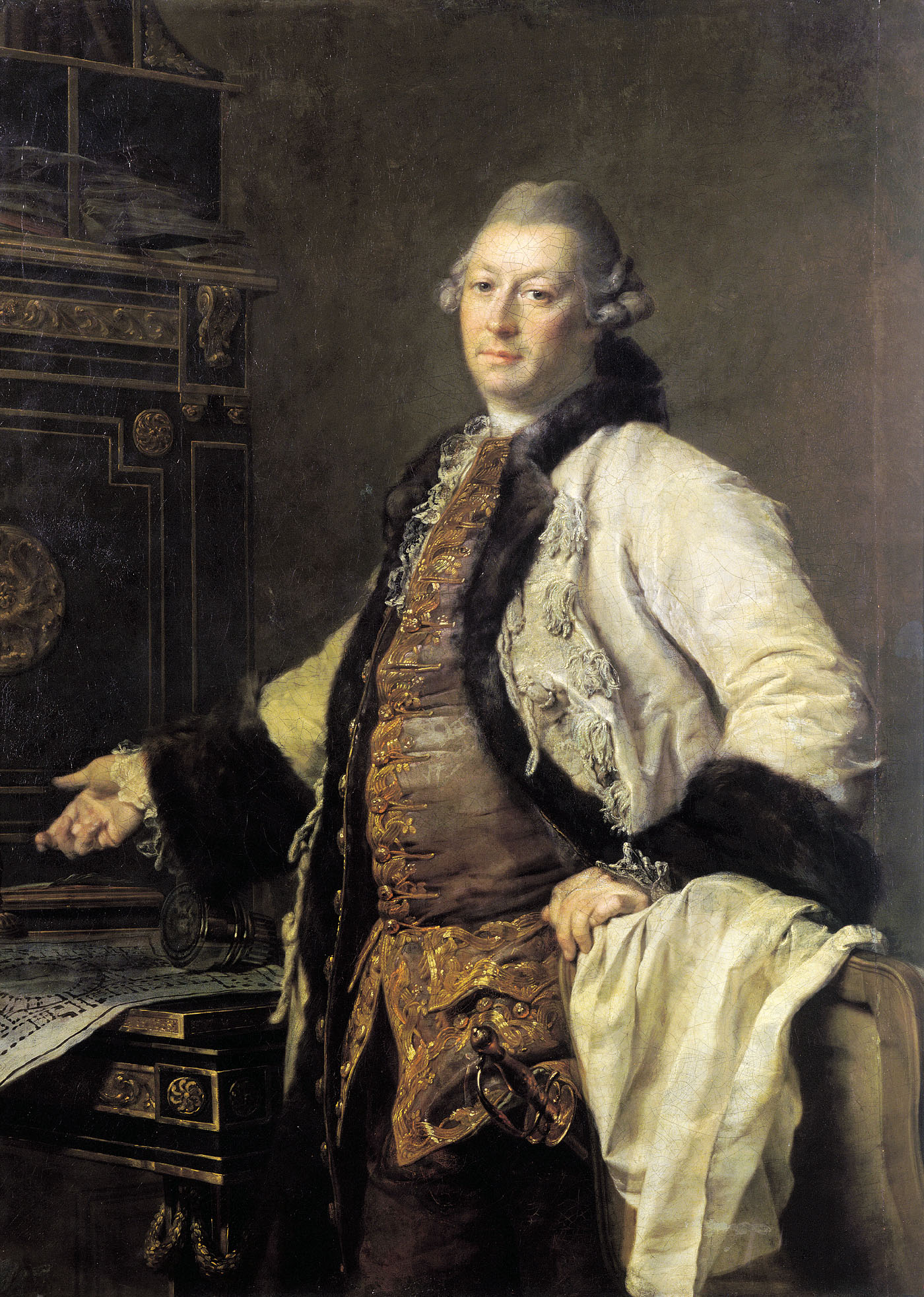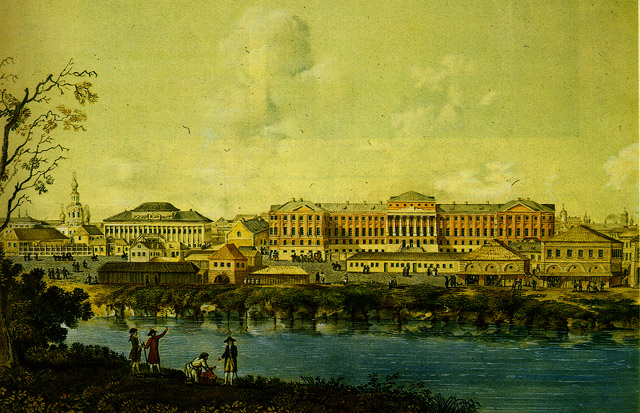|
Alexander Kokorinov
Alexander Filippovich Kokorinov (russian: Александр Филиппович Кокоринов) (10 July 1726 – 21 March 1772) was a Russian architect and educator of Siberian origin, one of the founders, the first builder, director (1761) and rector (1769) of the Imperial Academy of Arts in Saint Peterburg. Kokorinov has been house architect of the Razumovsky family and Ivan Shuvalov, the first President of the Academy. Kokorinov's surviving architectural legacy, once believed to be substantial, has been reduced by recent research to only two buildings, the Imperial Academy of Arts and Kirill Razumovsky palace in Saint Petersburg. The Academy was designed by Jean-Baptiste Vallin de la Mothe based on an earlier proposal by Jacques-François Blondel, while Kokorinov managed the construction in its early phases (1764–1772). Biography Early Years and Family Alexander Kokorinov was born in Tobolsk in the family of a government clerk. His grandfather was a priest. At the age ... [...More Info...] [...Related Items...] OR: [Wikipedia] [Google] [Baidu] |
Levitsky Kokrinov
Levitsky may refer to: * Fred Momotenko-Levitsky (born 1970), composer * Grigory Andreevich Levitsky Grigory Andreevich Levitsky (19 November 1878 – 20 May 1942) was a Russian and Soviet plant cytogeneticist. He worked along with Nikolai Vavilov who examined the role of mitochondria in plant heredity while also studying polyploidy and mutations. ... (1878–1942), Russian and Soviet plant cytogeneticist * Maxym Levitsky (born 1972), footballer * Melvyn Levitsky (born 1938), diplomat * Mykhajlo Levitsky (1774-1858), archbishop * Rafail Levitsky (1847-1940), artist * Sergei Lvovich Levitsky, Sergey Levitsky (1819–1898), photographer * Stepan Levitsky (1876-1924), chess master * Steven Levitsky, political scientist See also * Levitzky {{Surname East Slavic-language surnames Slavic-language surnames Levite surnames Jewish surnames Yiddish-language surnames ... [...More Info...] [...Related Items...] OR: [Wikipedia] [Google] [Baidu] |
Moscow Kremlin
The Kremlin ( rus, Московский Кремль, r=Moskovskiy Kreml', p=ˈmɐˈskofskʲɪj krʲemlʲ, t=Moscow Kremlin) is a fortified complex in the center of Moscow founded by the Rurik dynasty. It is the best known of the kremlins (Russian citadels), and includes five palaces, four cathedrals, and the enclosing Kremlin Wall with Kremlin towers. In addition, within this complex is the Grand Kremlin Palace that was formerly the Tsar's Moscow residence. The complex now serves as the official residence of the President of the Russian Federation and as a museum with almost 3 million visitors in 2017. The Kremlin overlooks the Moskva River to the south, Saint Basil's Cathedral and Red Square to the east, and the Alexander Garden to the west. The name "''Kremlin''" means "fortress inside a city", and is often also used metonymically to refer to the government of the Russian Federation. It previously referred to the government of the Soviet Union (1922–1991) and its high ... [...More Info...] [...Related Items...] OR: [Wikipedia] [Google] [Baidu] |
Doric Order
The Doric order was one of the three orders of ancient Greek and later Roman architecture; the other two canonical orders were the Ionic and the Corinthian. The Doric is most easily recognized by the simple circular capitals at the top of columns. Originating in the western Doric region of Greece, it is the earliest and, in its essence, the simplest of the orders, though still with complex details in the entablature above. The Greek Doric column was fluted or smooth-surfaced, and had no base, dropping straight into the stylobate or platform on which the temple or other building stood. The capital was a simple circular form, with some mouldings, under a square cushion that is very wide in early versions, but later more restrained. Above a plain architrave, the complexity comes in the frieze, where the two features originally unique to the Doric, the triglyph and gutta, are skeuomorphic memories of the beams and retaining pegs of the wooden constructions that preceded stone Do ... [...More Info...] [...Related Items...] OR: [Wikipedia] [Google] [Baidu] |
Corinthian Order
The Corinthian order (Greek: Κορινθιακός ρυθμός, Latin: ''Ordo Corinthius'') is the last developed of the three principal classical orders of Ancient Greek architecture and Roman architecture. The other two are the Doric order which was the earliest, followed by the Ionic order. In Ancient Greek architecture, the Corinthian order follows the Ionic in almost all respects other than the capitals of the columns. When classical architecture was revived during the Renaissance, two more orders were added to the canon: the Tuscan order and the Composite order. The Corinthian, with its offshoot the Composite, is the most ornate of the orders. This architectural style is characterized by slender fluted columns and elaborate capitals decorated with acanthus leaves and scrolls. There are many variations. The name ''Corinthian'' is derived from the ancient Greek city of Corinth, although the style had its own model in Roman practice, following precedents set by the Tem ... [...More Info...] [...Related Items...] OR: [Wikipedia] [Google] [Baidu] |
Dmitry Shvidkovsky
Dmitry Shvidkovsky (russian: Дмитрий Олегович Швидковский, born 14 May 1959) is a Russian educator and historian of architecture of Russia and the United Kingdom during the Age of Enlightenment. A 1982 alumnus and long-term professor of Moscow Architectural Institute, Shvidkovsky was appointed its rector in 2007. Biography Dmitry Shvidkovsky was born in Moscow. He is the son of historian Oleg Shvidkovsky, author of ''General History of Arts'' and ''Building in the U.S.S.R., 1917-1932''; his mother hails from the Mamontov dynasty. Shvidkovsky is the author of the definitive biography of Charles Cameron and a series of essays on contemporary British artists (William Hastie, Adam Menelaws) in Russia and their role in Russian art. In 1997 Shvidkovsky was awarded the medal of the Russian Academy of Arts for his 1996 books ''St. Petersburg: Architecture of the Tsars'' and ''The empress & the architect: British architecture and gardens at the court of Cath ... [...More Info...] [...Related Items...] OR: [Wikipedia] [Google] [Baidu] |
Académie Royale D'architecture
The Académie Royale d'Architecture (; en, "Royal Academy of Architecture") was a French learned society founded in 1671. It had a leading role in influencing architectural theory and education, not only in France, but throughout Europe and the Americas from the late 17th century to the mid-20th.Cleary 1996. History The Académie Royale d'Architecture was founded on December 30, 1671, by Louis XIV, king of France under the impulsion of Jean-Baptiste Colbert. Its first director was the mathematician and engineer François Blondel (1618–1686), and the secretary was André Félibien (1619 –1695). The academy was housed in the Louvre for most of its existence, and included a school of architecture. Its members met weekly. Jacques-François Blondel describes the academy quarters in his ''Architecture françoise'' of 1756. The main rooms were on the ground floor and included two lecture halls, one for meetings of the academy members on Mondays and mathematics lectures on Wednesd ... [...More Info...] [...Related Items...] OR: [Wikipedia] [Google] [Baidu] |
French Rococo And Neoclassicism
18th-century French art was dominated by the Baroque, Rocaille and neoclassical movements. History In France, the death of Louis XIV in September 1715 led to a period of licentious freedom commonly called the Régence. The heir to Louis XIV, his great-grandson Louis XV of France, was only 5 years old; for the next seven years France was ruled by the regent Philippe II of Orléans. Versailles was abandoned from 1715 to 1722. Painting turned toward " fêtes galantes", theater settings and the female nude. Painters from this period include Antoine Watteau, Nicolas Lancret and François Boucher. One of the best places in the UK to see examples of French visual and decorative arts of the Rococo and neoclassical periods is in the Wallace Collection, a free national gallery in London. The Louis XV style of decoration (although already apparent at the end of the last reign) was lighter: pastels and wood panels, smaller rooms, less gilding and fewer brocades; shells and garlands and o ... [...More Info...] [...Related Items...] OR: [Wikipedia] [Google] [Baidu] |
Baroque
The Baroque (, ; ) is a style of architecture, music, dance, painting, sculpture, poetry, and other arts that flourished in Europe from the early 17th century until the 1750s. In the territories of the Spanish and Portuguese empires including the Iberian Peninsula it continued, together with new styles, until the first decade of the 19th century. It followed Renaissance art and Mannerism and preceded the Rococo (in the past often referred to as "late Baroque") and Neoclassical styles. It was encouraged by the Catholic Church as a means to counter the simplicity and austerity of Protestant architecture, art, and music, though Lutheran Baroque art developed in parts of Europe as well. The Baroque style used contrast, movement, exuberant detail, deep colour, grandeur, and surprise to achieve a sense of awe. The style began at the start of the 17th century in Rome, then spread rapidly to France, northern Italy, Spain, and Portugal, then to Austria, southern Germany, and Russia. B ... [...More Info...] [...Related Items...] OR: [Wikipedia] [Google] [Baidu] |
Moscow State University
M. V. Lomonosov Moscow State University (MSU; russian: Московский государственный университет имени М. В. Ломоносова) is a public research university in Moscow, Russia and the most prestigious university in the country. The university includes 15 research institutes, 43 faculties, more than 300 departments, and six branches (including five foreign ones in the Commonwealth of Independent States countries). Alumni of the university include past leaders of the Soviet Union and other governments. As of 2019, 13 List of Nobel laureates, Nobel laureates, six Fields Medal winners, and one Turing Award winner had been affiliated with the university. The university was ranked 18th by ''The Three University Missions Ranking'' in 2022, and 76th by the ''QS World University Rankings'' in 2022, #293 in the world by the global ''Times Higher World University Rankings'', and #326 by ''U.S. News & World Report'' in 2022. It was the highest-ran ... [...More Info...] [...Related Items...] OR: [Wikipedia] [Google] [Baidu] |
Francesco Bartolomeo Rastrelli
Francesco Bartolomeo Rastrelli (russian: Франче́ско Бартоломе́о (Варфоломе́й Варфоломе́евич) Растре́лли; 1700 in Paris, Kingdom of France – 29 April 1771 in Saint Petersburg, Russian Empire) was an Italian architect who worked mainly in Russia. He developed an easily recognizable style of Late Elizabethan baroque, Baroque, both sumptuous and majestic. His major works, including the Winter Palace in Saint Petersburg and the Catherine Palace in Tsarskoye Selo, are famed for extravagant luxury and opulence of decoration. Biography Rastrelli was born in 1700 in Paris, where his father, Carlo Bartolomeo Rastrelli (1675–1744), a Florentine sculptor and architect who had trained in Rome, was active. Nothing is known about Francesco's Parisian years, but it seems certain that the young man trained and worked in his father's workshop. In 1716, Bartolomeo moved to Saint Petersburg, which became a new Russian capital just a four ... [...More Info...] [...Related Items...] OR: [Wikipedia] [Google] [Baidu] |
Moscow University
M. V. Lomonosov Moscow State University (MSU; russian: Московский государственный университет имени М. В. Ломоносова) is a public research university in Moscow, Russia and the most prestigious university in the country. The university includes 15 research institutes, 43 faculties, more than 300 departments, and six branches (including five foreign ones in the Commonwealth of Independent States countries). Alumni of the university include past leaders of the Soviet Union and other governments. As of 2019, 13 Nobel laureates, six Fields Medal winners, and one Turing Award winner had been affiliated with the university. The university was ranked 18th by ''The Three University Missions Ranking'' in 2022, and 76th by the ''QS World University Rankings'' in 2022, #293 in the world by the global ''Times Higher World University Rankings'', and #326 by '' U.S. News & World Report'' in 2022. It was the highest-ranking Russian educational ... [...More Info...] [...Related Items...] OR: [Wikipedia] [Google] [Baidu] |


.jpg)




